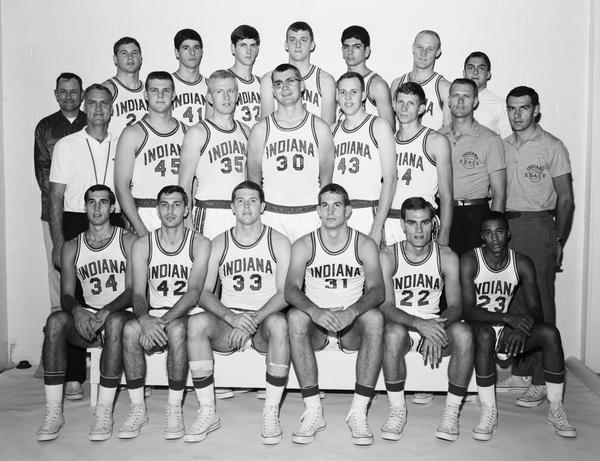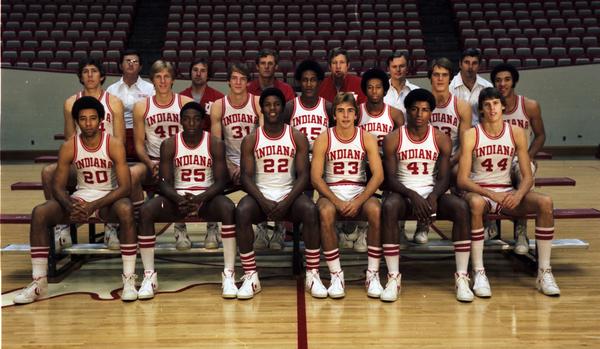Indiana University basketball is coming off a challenging 16-15 year one under head coach Archie Miller. Despite that, with a resurgence in recruiting and the return of a solid core of veterans, expectations are back in Bloomington.
That got us thinking — what have been the best year over year improvements throughout the history of Indiana basketball? What we found were several such seasons, under several different coaches. It’s a good reminder that we have been here before — and it gives us hope that it can happen again.
1937-38 (10-10) to 1938-39 (17-3)
New head coach Branch McCracken got immediate results in year one after replacing Everett Dean. McCracken came to Indiana from Ball State, and had guided the Cardinals to a 42-38 win over IU in the 1937-38 season. Under McCracken’s direction, IU handled Ball State easily to open the season in 1938, signaling that a turnaround was under way. The Hoosiers sat at 9-1 and in first place in the Big Ten before dropping their final two games and finishing second. Nevertheless, the trend was established and would lead to a 1940 national championship.
1944-45 (10-11) to 1945-46 (18-3)
Harry Good’s last year filling in for McCracken, who had taken a leave of absence for World War II, would mark a significant improvement in fortunes for the Hoosiers. IU was led by All-American John Wallace, who broke Ernie Andres’ single season scoring record with 250 points. Senior guard and captain Dick Wittenbraker returned from war and helped lead the resurgence. Unfortunately he suffered a midseason illness that foreced him to miss the second half of the year. IU finished in second place in the Big Ten.
1947-48 (8-12) to 1948-49 (14-8)

IU did more than change their record in the 1948-1949 season — they helped to change society. Shelbyville, Indiana native Bill Garrett became the first African-American to play for IU on December 4, 1948 at the Old Fieldhouse. Later that same year the sophomore again broke a color barrier as he became the first African-American to play in a Big Ten basketball game on Janury 8, 1949 — before a packed house of 10,013 at the Old Fieldhouse.
1958-59 (11-11) to 1959-60 (20-4)
If he isn’t the greatest IU player of all-time, he is most certainly one of the more unheralded IU greats ever. After a solid sophomore season the year before, the 1959-60 season saw Walt Bellamy become dominant, averaging 22.4 points and 13.5 rebounds. Senior Frank Radovich was also instrumental in the revival. This may have been Branch McCracken’s best team that didn’t win a title. Ultimately the Hoosiers couldn’t get past eventual national champion Ohio State — a team that included Bob Knight. Knight and the Buckeyes won the final game played at the Old Fieldhouse that year.
1963-64 (9-15) to 1964-65 (19-5)
Seniors Tom and Dick Van Arsdale were not about to see a twin season of the disappointing 1963-64 campaign, especially not in the final season of IU legendary coach Branch McCracken. An all-time classic game may have decided the season, as Cazzie Russell and No. 1 Michigan won an overtime thriller at the new IU Fieldhouse. Nevertheless, Indiana sent McCracken off with a solid final season that culminated with his final home win, 90-79 over Purdue.
1965-66 (8-16) to 1966-67 (18-8)

New IU head coach and former star player Lou Watson struggled to replace McCracken and the Van Arsdales in his first season. Indiana finished last in the Big Ten in 1966 — something that never happened under McCracken. With attendance in decline, Watson engineered the turnaround along with Butch Joyner and Vernon Payne. Indiana would complete the last to first season, and advance to the NCAA tournament for the first time in nine years.
1969-70 (7-17) to 1970-71 (17-7)
The roller coaster ride under Watson continued. After missing the entire 1969-70 season recovering from surgery, Watson returned in 1970-71. He came back with a secret weapon in first year player George McGinnis, who would go on to have the best one and done career in Indiana history. McGinnis led the Big Ten in both scoring (29.9) and rebounding (14.9). Fellow sophomore Steve Downing recorded the only triple-double in school history as the duo led the resurgence in Bloomington.
1971-72 (17-8) to 1972-73 (22-6)
While the improvement in wins and losses was not as dramatic as the others, this season represented a significant shift in the culture and ultimately the direction of the program. IU’s forgotten Final Four team under second year coach Bob Knight ultimately fell to 7-time defending champion UCLA. Knight has often referred to this team as one of his favorites, as the players bought-in to an entirely new system. That included Steve Downing, who thrived under both Watson and Knight, and became a first round draft choice of the Boston Celtics.
1976-77 (16-11) to 1977-78 (21-8)

Many Hoosier fans forget that the 1976 perfect season was followed by a major let down. Indiana’s true 1976-77 record was 14-13 before Minnesota was forced to forfeit two wins over the Hoosiers. IU successfully rebuilt their roster and came back strong for the 1977-78 season. Indiana reeled off eight straight conference wins to close out the year in second place behind only Magic Johnson and Michigan State. Led by captains Jim Wisman and Wayne Radford along with emerging sophomores Butch Carter and Mike Woodson, IU advanced to the Sweet 16 of the NCAA tournament.
1989-90 (18-11) to 1990-91 (29-5)
Indiana was coming off of one of only two seasons in which Bob Knight had a losing record in the Big Ten. The 1989 recruiting class, perhaps the greatest class in Indiana history, had a year under their belt and were joined by freshman sensation Damon Bailey. Despite only three upperclassmen on the entire roster (and just one senior), Indiana finished in a first place tie with Ohio State. IU lost in the Sweet 16 round to eventual national runner-up Kansas.
2010-11 (12-20) to 2011-12 (27-9)
This season needs little introduction to Hoosier fans young and old. In what was perhaps the greatest turnaround season in program history — the revival had a signature moment. Christian Watford’s buzzer beater at Assembly Hall in December of that season propelled Indiana over No. 1 Kentucky and marked the end of a brutal three year rebuild. The Hoosiers would go on to make the NCAA Tournament before their old nemesis Kentucky eliminated them in the Sweet 16 round.
You can follow us on Twitter: @daily_hoosier
Find us on Facebook: thedailyhoosier




